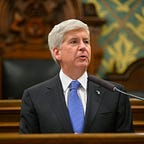History of the Original Marshall Plan
By: Ty Carson
Sixty-four years ago today, on December 10, 1953, George C. Marshall was awarded the Nobel Prize for Peace for a revolutionary plan.
The United States has an expansive history of helping other countries in their time of need. One of the most noteworthy situations was the Marshall plan, officially known as the European Recovery Program (ERP), developed by then-Secretary of State George Marshall in 1948.
After World War II, the Europe accelerated into an economic crisis. Even with the European country’s contributions, there simply weren’t enough funds available to assist in the recovery of their homelands. European people were fending for themselves to survive. George Marshall recognized this dilemma and put a plan into action.
“The truth of the matter is that Europe’s requirements for the next 3 or 4 years of foreign food and other essential products — principally from America — are so much greater than her present ability to pay that she must have substantial additional help, or face economic, social, and political deterioration of a very grave character.” — From the Marshall Plan by George Marshall
His plan involved asking the United States for assistance. When presented with the situation in Europe at the time, the United States originally offered $20 billion dollars for recovery aid with the indication that the European countries had to work together to decide what the money would go toward.
Marshall encouraged the countries to work together to create a cohesive plan that they all agreed upon. He stated in his speech that if they were going to create a plan, it should be a “joint one, agreed to by a number, if not all European nations.”
“The remedy lies in breaking the vicious circle and restoring the confidence of the European people in the economic future of their own countries and of Europe as a whole. The manufacturer and the farmer throughout wide areas must be able and willing to exchange their products for currencies the continuing value of which is not open to question.” — From the Marshall Plan by George Marshall
Marshall was assisted in getting the plan implemented by at least one Michigander — Sen. Arthur Vandenberg. Sen. Vandenberg was also credited with helping transition the Republican Party’s foreign policy of isolationism to one of internationalism
Of course, borrowing the money from the United States came with its restrictions. The United States focused on several advantages that would help create a profitable relationship with the European Nation. The European Nation would purchase the necessary products from the United States to boost America’s economy. They also focused on making the people of Europe work together to enhance trade and boost their economies.
Overall, the United States gave the European countries about $13 billion to help in the recovery. The impact of the Marshall plan was so incredible that in 1997 President Bill Clinton was joined by leaders from 36 European countries who met in the Netherlands to celebrate the 50th anniversary of the landmark plan.
Anne Swardson, previously the Washington Post’s Foreign Service reporter and current Senior Editor at Bloomberg, covered the anniversary meeting. In her article for the Washington Post Swardson wrote, “For Americans who were alive then, the Marshall Plan is a warm but fading memory of a time when the United States — inspired in part by a large injection of anti-communism — meant more than an unwelcome Yankee. But here in Europe, the legacy of the Marshall Plan is visible for all to see: in high-tech railways and highways, in prosperous, modern cities, in products from perfume to fighter jets. Four of the seven richest nations on Earth are European recipients of Marshall Plan assistance.”
In that same article, Swardson further captures the importance of the Marshall Plan by reciting the opinion of a famous leader, stating, “Winston Churchill once called it ‘the most unsordid act in history.”
The Marshall Plan truly demonstrates the incredible things that can be accomplished by putting aside difference and working together for the common good. After the war it would have been easy for the U.S. to simply sit back and begin to focus on the country’s return to normalcy, and most people paying attention to the short-term would have done just that. Thankfully, Secretary Marshall looked at the larger picture and realized that down the road the U.S. and the rest of the world would be better off sharing resources and coming together for the big win.
